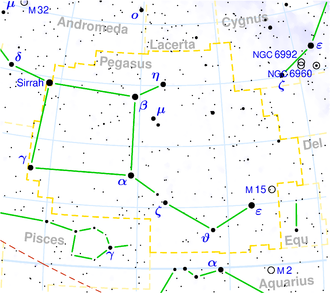Scheat
|
Stern Scheat (β Pegasi) |
|||||||||||||||||||||
|---|---|---|---|---|---|---|---|---|---|---|---|---|---|---|---|---|---|---|---|---|---|
| AladinLite | |||||||||||||||||||||
|
Observation dates equinox : J2000.0 , epoch : J2000.0 |
|||||||||||||||||||||
| Constellation | Pegasus | ||||||||||||||||||||
| Right ascension | 23 h 03 m 46.46 s | ||||||||||||||||||||
| declination | + 28 ° 04 ′ 58 ″ | ||||||||||||||||||||
| Apparent brightness | 2.44 (2.31 to 2.74) mag | ||||||||||||||||||||
| Typing | |||||||||||||||||||||
| B − V color index | +1.67 | ||||||||||||||||||||
| U − B color index | +1.96 | ||||||||||||||||||||
| R − I index | +1.32 | ||||||||||||||||||||
| Spectral class | M2 II-IIIvar | ||||||||||||||||||||
| Variable star type | SR | ||||||||||||||||||||
| Astrometry | |||||||||||||||||||||
| Radial velocity | (8.0 ± 0.3) km / s | ||||||||||||||||||||
| parallax | (16.64 ± 0.15) mas | ||||||||||||||||||||
| distance | (196.0 ± 1.8) Lj (60.10 ± 0.54) pc |
||||||||||||||||||||
| Visual absolute brightness M vis | −1.45 mag | ||||||||||||||||||||
| Proper movement | |||||||||||||||||||||
| Rec. Share: | (187.65 ± 0.12) mas / a | ||||||||||||||||||||
| Dec. portion: | (136.93 ± 0.12) mas / a | ||||||||||||||||||||
| Physical Properties | |||||||||||||||||||||
|
Other names and catalog entries |
|||||||||||||||||||||
|
|||||||||||||||||||||
| annotation | |||||||||||||||||||||
|
|||||||||||||||||||||
Scheat (from Arabic ساق, DMG sāq ‚Bein ', Bayer name : Beta Pegasi , abbreviated β Peg ) is a variable star of the CO-Cygni type in the constellation Pegasus . Scheat marks the northeastern corner of the Pegasus Square. Its brightness fluctuates between +2.31 and +2.74 mag with a period of about 43 days. Scheat is a red giant of the spectral class M2. It is about 200 light years from Earth. Other names are Menkib and Seat Alpheras .
See also
Web links
Individual evidence
- ↑ a b c Hipparcos catalog (ESA 1997)
- ↑ a b c bet Peg. In: VSX. AAVSO, accessed October 29, 2018 .
- ↑ a b c Bright Star Catalog
- ↑ Pulkovo radial velocities for 35493 HIP stars
- ↑ a b c Hipparcos, the New Reduction (van Leeuwen, 2007)
